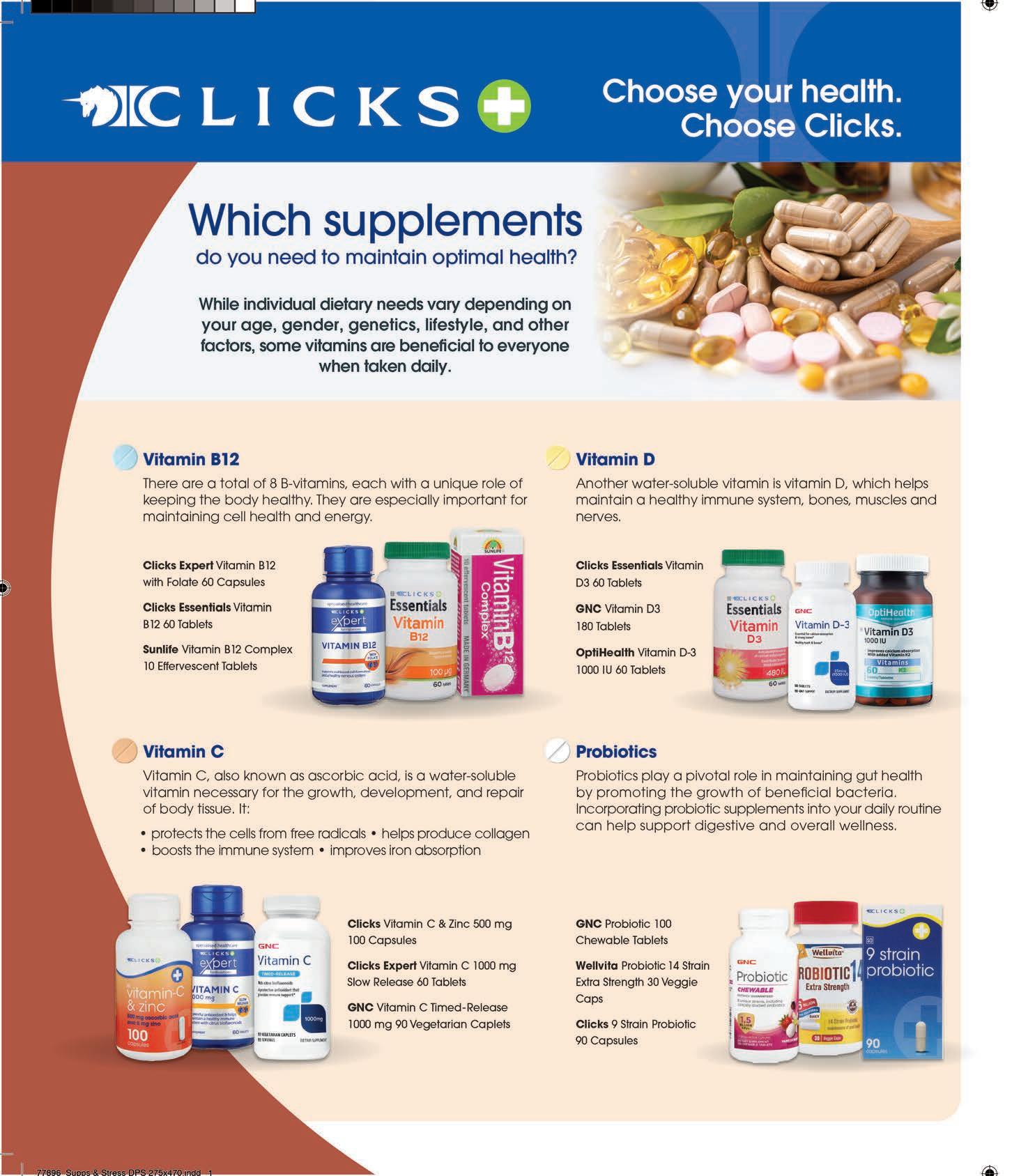







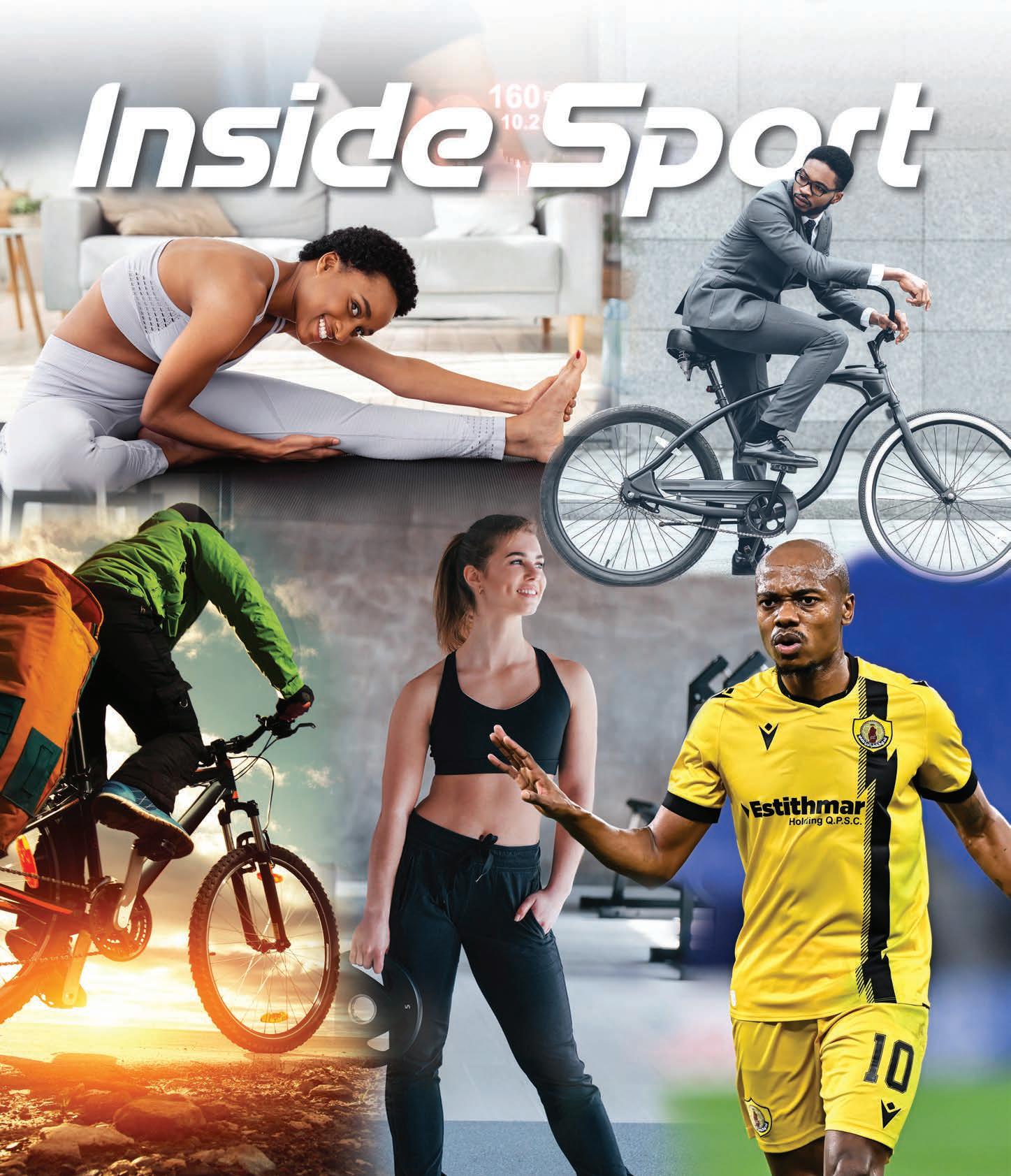



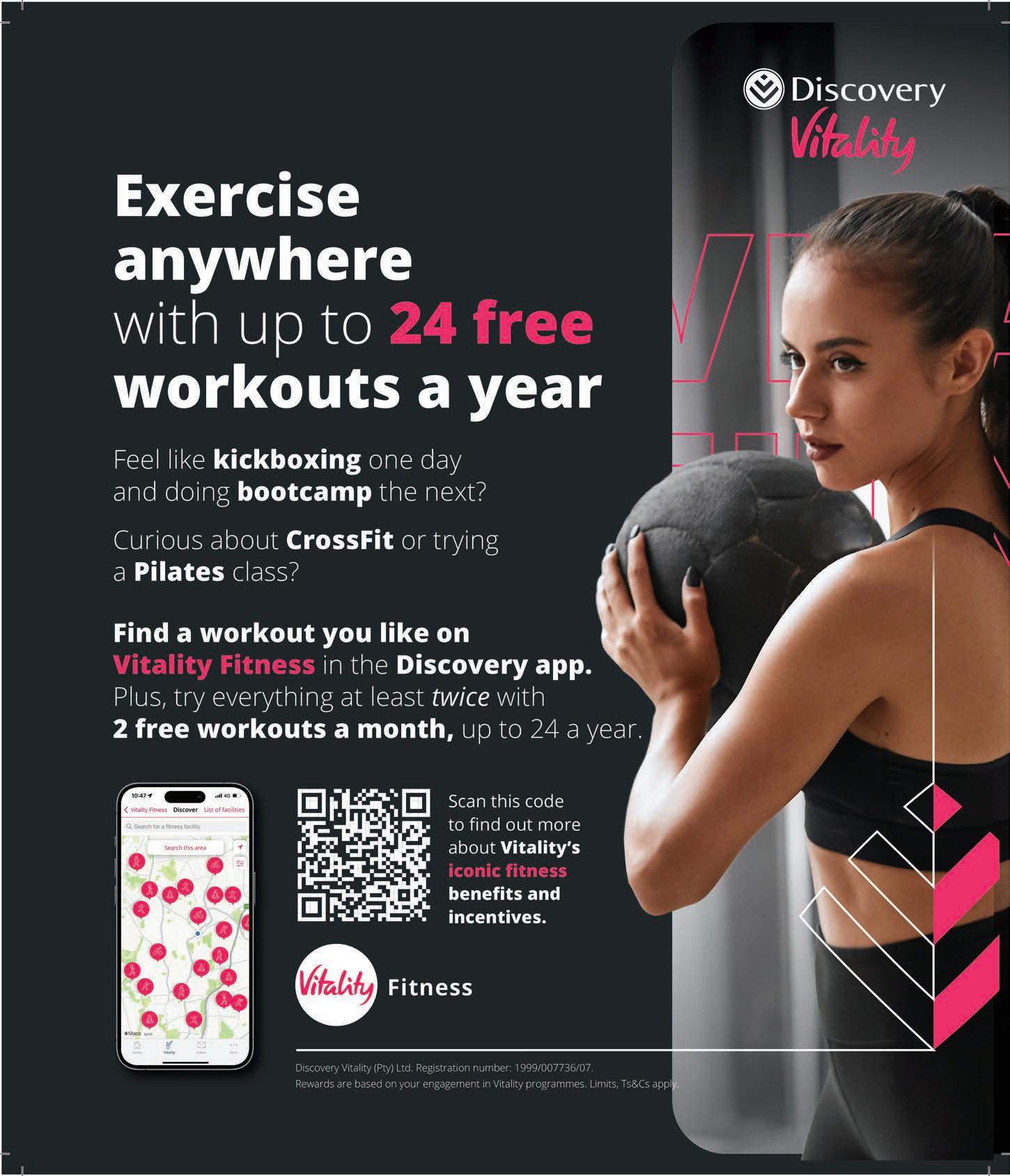
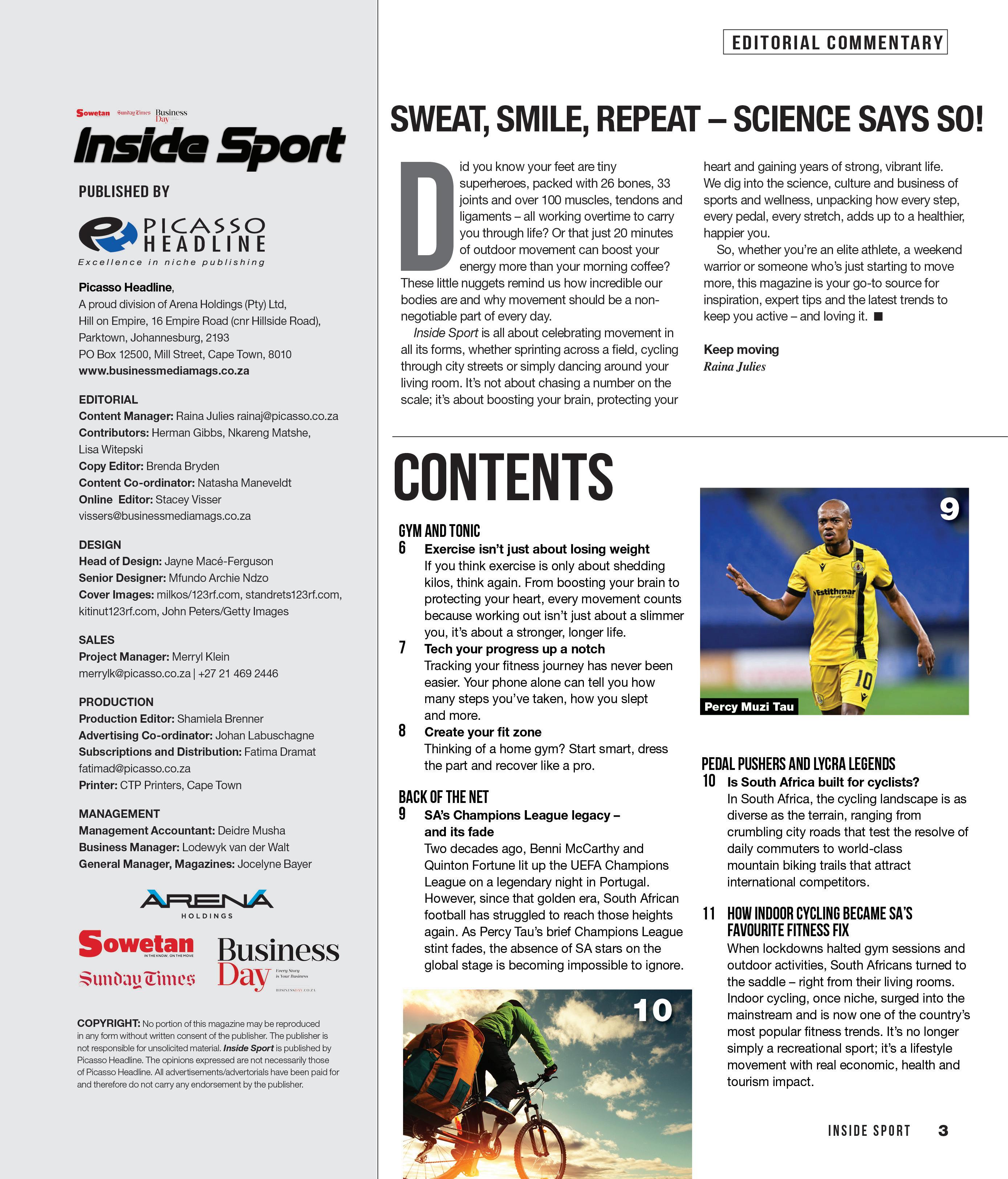


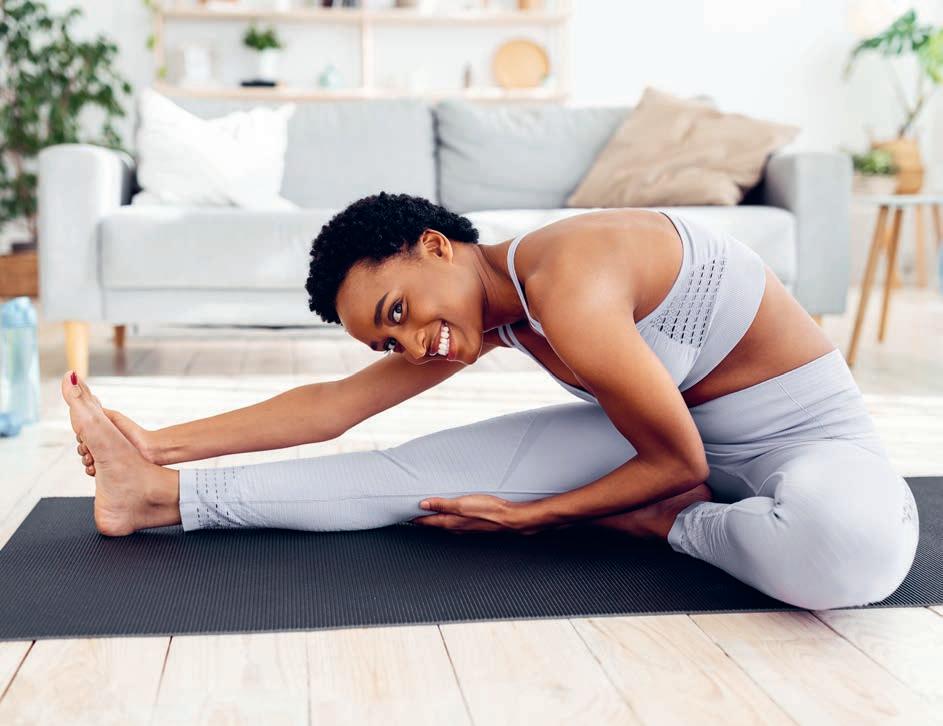


















If you think exercise is only about shedding kilos, think again. From boosting your brain to protecting your heart, every movement counts because working out isn’t just about a slimmer you, it’s about a stronger, longer life. By LISA WITEPSKI
If there were a pill that reduced your risk of dementia, depression and even cancer, you’d take it. However, science says the real magic lies in movement. The UK’s Alzheimer’s Society reports that regular physical exercise is one of the most effective ways to reduce your risk of developing dementia. The mood-lifting power of movement is just as potent – exercise is almost twice as effective as medication in treating depression, while the CDC links regular physical activity to lower incidences of certain cancers.
Forget the one-size- ts-all mindset. Different workouts offer unique bene ts, says physiotherapist and CEO of JEFF Fitness Dominique Leclerq. Karen Loader, owner of F45 Training in Bryanston and Fourways, agrees adding: “Working on movements like lifting, squatting, pushing and pulling mean you’re able to do key activities.” Here they mention a few speci c activities to try:
• Yoga improves balance, posture and exibility, while helping you destress and feel grounded.
• Pilates strengthens your core and boosts stability.


• Weight training builds muscle, improves bone density and supports joint health – and it’s great for your mental game too.
• Boxing gets your heart rate up and sharpens co-ordination, re exes and posture.
• Functional training such as lifting, squatting, pushing and pulling prepares your body for real-life movements. Think lifting groceries without straining your back.
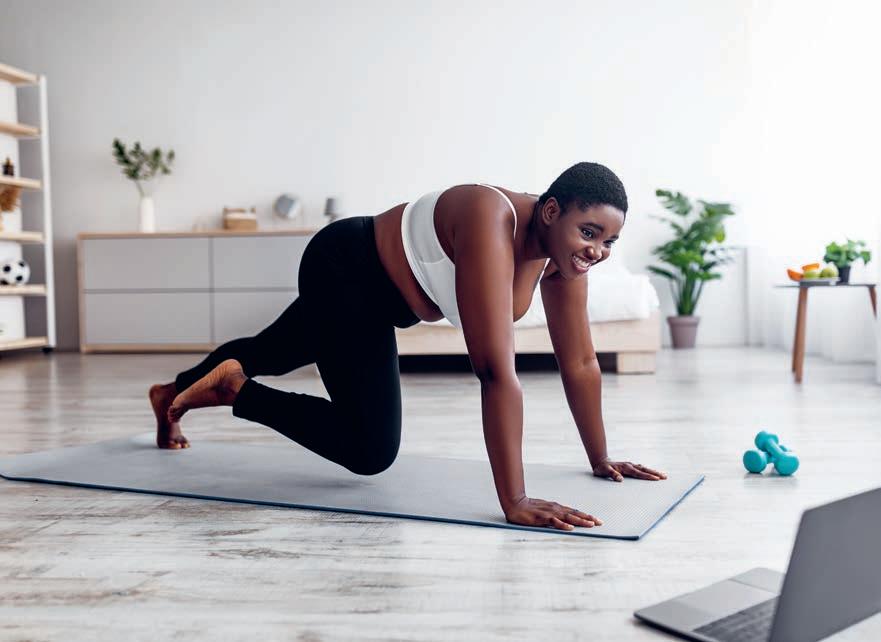
Not sure where to start? Begin with your why: are you aiming for weight loss, strength, endurance or better mobility? Then pick an activity you enjoy because the best workout is the one you’ll stick with.
And don’t stress about making it to the gym. Home workouts can be just as effective. “Consistency, effort and intention beat specialist equipment, which is why home workouts can be just as effective as a gym session, plus they have the bene t of being exible, time-ef cient and cost-effective,” says Leclerq. However, she adds that a structured programme with clear goals and a regular schedule are key to seeing results. Challenge yourself by tweaking reps, tempo and resistance, and choose compound moves like lunges and push-ups for maximum bang for your buck.
“A STRUCTURED PROGRAMME WITH CLEAR GOALS AND A REGULAR SCHEDULE ARE KEY TO SEEING RESULTS.” – DOMINIQUE LECLERQ

Skateboarding isn’t just for the youth. A 2021 study found that adults over 40 who skate experience reduced stress, better balance and boosted self-esteem. One skater called it “therapy on four wheels”.
Source: International Review for the Sociology of Sport
Tracking your fitness journey has never been easier. Your phone alone can tell you how many steps you’ve taken, how you slept and more, but don’t drown in data.
Focus on the basics, says strength and conditioning coach Deen Boomgaard.
• Heart rate: monitor for safety and to optimise workouts.
• Step count: a gentle nudge to keep moving.
• Timer apps: great for timing sets and intervals.
While wearables can help you get the most out of your workout, they can help you recover, too. Loader says that her favourite wearable is her Whoop, which guides her choices based on the data available. “Wearables like this offer extra insights, like how that glass of wine affects your recovery or, if I’m not
sleeping well, the AI-enabled coach will offer me tips.”
Boomgaard reminds us that rest and sleep are crucial for progress. Minimise stimulants and screens before bed to help your body repair and strengthen overnight.
Leclerq adds: “Rest days aren’t slacking; they’re part of the plan. Your body builds muscle during rest.”
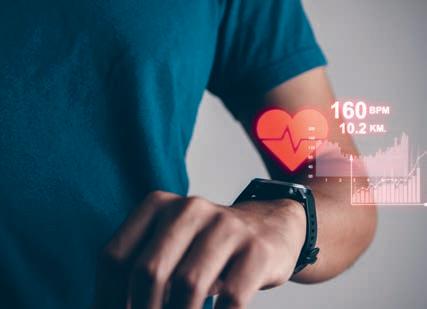
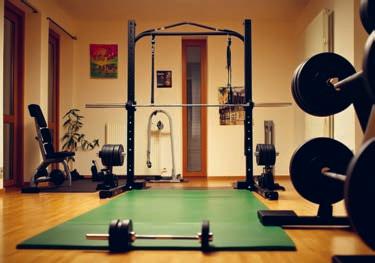
Thinking of a home gym? Start smart, says Levi Silverman of MaxFit SA:
1. Start with flooring: choose sweat-proof, easy-clean, shock-absorbing surfaces.
2. Think vertical: wall-mounted equipment saves space.
3. Essential gear: multifunctional trainer, bench, dumbbells, barbell and pull-up bar.
Supplements can help, but start with real food. If you’re focused on building strength, you might need extra protein –just read those labels carefully.
Boomgaard recommends creatine, a misunderstood powerhouse:
• It improves energy production.
• It boosts nutrient transport.
• It enhances metabolic function.
• It supports hydration and recovery. Nutritional Performance Lab’s Andy Moore adds that creatine helps your cells produce energy, while also helping with nutrient transport, thermoregulation and metabolic function. “This,” he says, “bolsters recovery by offering enhanced hydration, because creatine effectively ‘pulls’ water into cells. Beyond exercise, creatine is also beneficial for menopausal women because it aids hormonal balance. Better bone density and cognitive function have also been recorded among people who use creatine daily.”

Loader says breathable fabrics are key; it’s important that your shirt does not stick to your skin while you are training. The details matter:
1.
So cks: go for moisture-wicking, c ushioned options to prevent blisters.
2.
Sports bras: for women, proper support is crucial – choose high-impact bras for cardio and lighter support for yoga.
3.
Headbands/gloves: these help manage sweat and protect your grip during strength training.
4. Look for compression wear for extra muscle support or fitted activewear that moves with your body.
Loader’s greatest fitness spend, however, is on shoes. She looks for three things:
• Support for lateral moves.
• Cushioning, but not too soft.
• Grip and stability for control.

Boomgaard notes that your shoes must be fitted to your discipline: “You wouldn’t play soccer without wearing studs, for instance.” That said, it’s not necessary to opt for the most expensive brand.
“If you’re focused on weight training, you can actually go barefoot; your toes will help grip, enabling you to lift heavier weights. But if you prefer to wear a shoe, a flatter sole is best.”
Remember that in all cases, fit is one of the most important factors. A poorly fitting shoe can impact your knees and ankles (especially if you are running), so be sure to have a professional fitting before purchasing.
Aim for 1.6g to 2.2g of protein per kilogram of body weight for optimal muscle repair and performance.
Two decades ago, Benni McCarthy and Quinton Fortune lit up the UEFA Champions League on a legendary night in Portugal. However, since that golden era, South African football has struggled to reach those heights again. As Percy Tau’s brief Champions League stint fades, the absence of SA stars on the global stage is becoming impossible to ignore, writes NKARENG MATSHE , Sowetan sports editor

One of the proudest moments of South African football on the international stage came on a Champions League Wednesday night in Oporto, Portugal, just over two decades ago.
An unfancied Porto side, led by Jose Mourinho, hosted Sir Alex Ferguson’s Manchester United in a Round of 16 crunch rst leg. Little did we know that two South Africans, Benni McCarthy and Quinton Fortune, would grab the headlines in that match that ended 2–1 in Porto’s favour.
“Benni 2, Quinton 1”, screamed one headline, illustrating how South Africa (SA) had set the international stage alight. McCarthy and Fortune colliding and making a mark at the highest echelon of club football was a joy
to watch. Here, were two SA youngsters from humble beginnings in Cape Town, representing their teams in the Champions League and scoring key, decisive goals in a knock-out tie.
Sadly, SA has not been able to replicate that kind of high standard. McCarthy, with that 2004 victory under Mourinho, remains the only South African to have won the Uefa Champions League to date.
More worryingly, there’s a lack of SA representativity in the elite competition, which speaks of the dwindling standards of domestic football.
McCarthy and Fortune had followed in the footsteps of the likes of Lucas Radebe, Shaun Bartlett and Mark Fish, among others. At Ajax Amsterdam, Steven Pienaar, a product of Westbury township in Johannesburg, was another who caught the eye when he went toe-to-toe with Patrick Vieira of Arsenal in a 2003 Group B clash at Highbury, London. When Pienaar deserted the Netherlands to start a legendary journey with Everton in England, Thulani Serero took over as a SA representative at Ajax, having come through from Ajax Cape Town. The Soweto-born mid elder stuck it out at the Dutch giants and was a regular in his six-year stay at the club. After a long lull, Percy Tau took over the mantle of SA’s greatest hope in 2018. He had had a stellar couple of seasons with Mamelodi
Sundowns, winning just about everything, including the CAF Champions League and Footballer of the Year accolade. He was set for the big time in Europe when Brighton came knocking with a mouthwatering offer.
When Brighton didn’t immediately see the need to put him into their rst team, opting to send him out on loan in Belgium, Tau took full advantage. He was player of the year for St Union in the lower leagues, and Club Brugge soon expressed interest in bene tting from his availability on loan. That helped Tau enter the Champions League – something he might not have experienced with Brighton.
Tau featured in high-pro le matches, including a 2–2 draw against Real Madrid. It was a fairytale – a young lad from Emalahleni, Mpumalanga, rubbing shoulders with the likes of Cristiano Ronaldo.
Since then, there has been a glaring absence of SA players at the high level, with some of the young prospects preferring obscure East European leagues, and others deciding it’s best to stay home – thanks to competitive salaries offered by PSL teams.
SA no longer exports as many international players – that is evident in the composition of the Bafana Bafana squad, with only Tau, Luke le Roux, Siyabonga Ngezana, Yaya Sithole and Elvis Mokwana a handful of those who regularly form the team’s foreign-based contingent – the rest ply their trade locally.
Liverpool’s incredible consistency earned them a second Premier League trophy in five years, a surprisingly great outcome for Arne Slot, their manager who replaced the revered Jurgen Klopp at the beginning of the season.
Dutchman Slot’s unpredictability took the PL by storm and Liverpool kept on winning and winning, only losing for the second time in the league away to Fulham on 6 April this year. Manchester City’s slump in form coincided with Ballon d’Or winner Rodri’s long-term injury and, at the time of writing, Pep Guardiola’s men were still to confirm a place in next season’s Champions League. Arsenal miraculously finished second again after an injury-hit season, illustrating that Mikel Arteta continues to build a competitive side. The relegated Southampton, Leicester and Ipswich simply didn’t have the budget to strengthen for the demands of the league.

The South African fitness equipment e-commerce market is predicted to reach $37.4-million by 2025 and accounts for 24.7 per cent of the individual sports e-commerce market in South Africa.
Source: eCommercedb


From urban streets to scenic trails: the diverse cycling landscape of South Africa
In South Africa, the cycling landscape is as diverse as the terrain, ranging from crumbling city roads that test the resolve of daily commuters to world-class mountain biking trails that attract international competitors.
The state of cycling in the country raises critical questions about infrastructure and safety, and if it fosters an environment conducive to leisure and competitive cycling.
THE
IS A RECURRING THEME.
Commuter cycling has surged in urban centres since many South Africans embraced two wheels as a means of transport amid the escalating costs of fuel and public transport. However, navigating city streets laden with potholes, insuf cient markings and a lack of designated bike lanes presents signi cant challenges.
Cyclists often express safety concerns, especially when sharing the road with aggressive drivers. They say they must constantly be alert to avoid accidents.
In contrast, competitive road racing in South Africa thrives, particularly in regions such as the Western Cape, where the Cape Town Cycle Tour has become a hallmark event on the global
cycling calendar. Yet, even within competitive circles, the need for improved safety measures and better road conditions is a recurring theme.
While urban cycling faces considerable hurdles, the country’s breathtaking landscapes bolster a robust mountain biking (MTB) scene.
South Africa is home to some of the most breathtaking trails globally, catering to seasoned pros and adventure seekers. Events like the Sani2c challenge cyclists to navigate rugged paths through lush mountains and scenic vistas, reinforcing South Africa’s reputation as a premier MTB destination.
However, maintaining these trails and ensuring they are accessible remains crucial to the sport’s growth.
Gone are the days when the local gym was the sole venue for a heart-pumping spin class. Today, the trend of cycling indoors has soared, ushering in a new era of tness where users can pedal away on state-of-the-art smart bikes or even standard bicycles out tted with simple accessories.
The allure of virtual classes and global cycling routes has transformed the mundane into thrilling expeditions from the comfort of one’s living room.
According to Bicycle South Africa, there’s been a 300 per cent growth in commuter cycling in Cape Town since the expansion of cycling lanes began in 2011.
How indoor cycling became SA’s favourite fitness fix
When lockdown halted gym sessions and outdoor activities, South Africans turned to the saddle – right from their living rooms. Indoor cycling, once niche, surged into the mainstream and is now one of the country’s most popular fitness trends.
The appeal lies in its convenience, low-impact and high-intensity burn. With smart bikes and platforms such as Zwift, Peloton, Wattbike Hub and try ROUVY for SA routes, riders now enjoy virtual group rides, interval challenges and scenic routes from Cape Town to Tokyo – all without leaving home.
According to Discovery Vitality, home workouts in South Africa increased by over 300 per cent in 2020, with cycling topping the list of preferred activities.

South African boutique studios like Ride Republic and Cycle Lab Active also jumped on the digital wave, offering streamed classes that blend high-energy soundtracks with instructor-led spin sessions.
Beyond fitness, indoor cycling has become a mental wellness tool, providing structure, stress relief and a sense of community during uncertain times. Whether a 20-minute ride or a 90-minute power climb, it’s no longer just about calories burned; it’s about riding strong, at home.
As power cuts and time constraints persist, indoor cycling proves it’s more than a pandemic trend; it’s a lifestyle revolution on two wheels.


Cycling in South Africa is shifting gears, from a recreational sport to a lifestyle movement with real economic, health and tourism impact. Across the country, cycling is rede ning wellness and drawing enthusiasts into a world where health, business and leisure collide.
As of 2025, the South African bicycle market is projected to be valued at approximately $1.42-billion. This estimate is based on a 7.5 per cent compound annual growth rate from the 2024 market value of $1.32-billion.
Source: Grand View Research
Health-conscious South Africans are turning to cycling for its low-impact cardiovascular bene ts and mental wellness. The Heart and Stroke Foundation South Africa (HFSA) encourages regular physical activity to reduce the risk of cardiovascular diseases, type 2 diabetes and other health issues. The HSFSA outlines bene ts such as lowering blood pressure, improving cholesterol levels and enhancing mental
wellbeing through the release of “feel-good” hormones during exercise as a top activity. And, Stellenbosch University’s Campus Health services note that activities like cycling can help maintain a healthy weight and keep the heart muscle t and healthy.
From Pavement to Purpose: Cycling as a daily habit
Many people are integrating cycling into daily routines, leading to the rise of commuter cyclists in urban areas like Cape Town and Johannesburg where cycling lanes and green routes are expanding.
On the tourism front, luxury cycling experiences are booming. In the Cape Winelands, companies like iRide Africa and Bikes ‘n Wines offer curated bike-and-wine tours that blend scenic rides with world-class wine tasting. These niche experiences attract local and international tourists alike, boosting hospitality and retail sectors.
Innovative trails like the Bicycle Empowerment Network (BEN) help develop eco-tourism routes in underserved communities using recycled bikes.
Source: BEN Bikes
The Cape Town Cycle Tour is the largest timed cycle race in the world, attracting over 30 000 riders annually from across the globe.
Source: Cape Town Cycle Tour
Corporate South Africa is also embracing the trend. Events like the Cape Town Cycle Tour not only promote tness, but also generate over R500-million annually for the economy through travel, accommodation and sponsorships, according to a report from Zawya.
Style in the Saddle
Riding alongside this boom is the rise of boutique cycling apparel brands, such as VYE® Cycling and VanH, that are capitalising on cycling’s lifestyle appeal. These South African labels offer high-performance, custom-designed kits that merge function with fashion, allowing cyclists to express individuality both on and off the bike.
As cycling pedals into the mainstream, it’s not just improving lives: it’s powering a wellness economy that looks good and feels even better.
Homegrown cycling apparel brands like VYE® Cycling have expanded into European and US markets, flying the local design flag high. Source: Vye
The gym apparel market in South Africa generated $784.2-million in 2024.
Source: Grand View Research+1Statista+1
